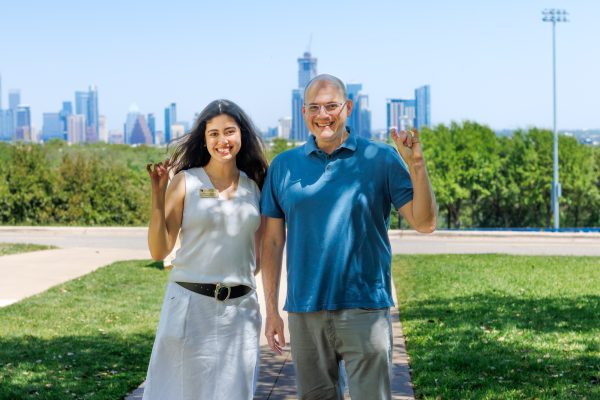Preserve hosts events for students, community
St. Edward’s University’s creative research center, Wild Basin Wilderness Preserve, held a volunteer work day that gave students an opportunity to help maintain the park’s trails for visitors.
Four volunteers showed up for the Oct. 28 workday, none of whom were St. Edward’s students.
“We hold this event once a month, every third Saturday,” said Mitch Robinson, land manager and education coordinator of the preserve. “We call it ‘land management.’ We have issues like putting down fencing and keeping the trails safe. A lot of what we’ve been doing is picking weeds and non-native species. We’ve also been dealing with trying to appease our neighbors and get them to understand what we’re doing here.”
Nature preserves in Austin like Wild Basin face a struggle to preserve native plants like Texas Live Oak and Spanish Oak, especially with an influx of non-native species.
“We’re at a confluence of different ecosystems,” Robinson said. “What happens is that if you have deer eating natural species, then non-native species have no predators. This is a big part of our time here, to encourage our neighbors to plant native species.”
Robinson has made an effort to encourage volunteers to aid Wild Basin in performing management duties.
Additionally, Wild Basin is a part of the larger Balcones Canyonlands Preserve (BCP) system, a network of preserves in Travis County managed by staff from the City of Austin, Travis County, the Lower Colorado River Authority, and in the case of Wild Basin, employees of St. Edward’s University.
“Part of the problem is that we don’t have enough staff,” Robinson said, in reference to the entire BCP. “We have about 30 staff members for 30,000 acres.”
Despite that, Wild Basin and the entire BCP has managed.
To continue this track record, Robinson encourages St. Edward’s students to lend a hand at Wild Basin, and states that it can be a valuable learning experience.
“It’s a good opportunity to see what managing a preserve system is like. A lot of people buy all the development [the preserve land] and then they think they’ve won. It’s a big issue. This place wouldn’t run without volunteers,” Robinson said. “You can not only do a good deed, but you’d be surprised on how much you can learn from two to three hours on the trail. I consider some of these people my family. It’s interesting to see even if you don’t have a science background.”
John Barr is one of the volunteers who helped out during the work day. He considers the volunteering experience a valuable one.
“One [benefit of working at the basin] is you get to know a place. When you walk the trails, you only get to know a little bit about it. But when you volunteer, you get a deeper understanding. Volunteering has started a process that helped me learn about the Hill Country. I started volunteering here, and all of a sudden, I started taking classes,” Barr said.
Barr is now a regular volunteer at the basin.
Volunteering is only one of the activities that the Basin involves itself in, however.
“I always try something new,” Robinson said.
Such activities include guided and unguided hikes. Barr leads hikes every second Saturday. Stargazing and moonlight hikes are other activities.
Wild Basin also hosts events for groups such as the Native Plant Society and the Girl Scouts of America.
Wild Basin is also involved in environmental education, one such effort being collaborative courses with ACC that reach out to high-risk upper elementary to middle school youth.
Casie Parish-Fisher, professor of forensic science at St. Edward’s, helps to teach these classes at the Basin.
“Wild Basin is a great place to bring kids to get them out of the city. They can enjoy nature and learn about recycling and reusing to help preserve our environment,” Fisher said. “It’s really important to go out to Wild Basin and volunteer whether it’s with a children’s group, girl scouts or just to volunteer to help clean up. It’s a great place to enjoy nature and to give back to the community without going too far from home.”
The preserve is located on the east side of Loop 360 at 805 North Capital of Texas Highway. The turn is about one mile north of Bee Cave Road. The offices are open from 9 a.m. to 4 p.m., and the trail is available for hiking from morning to sunset.






